
|
It will approach to Sun down to 0.4 a.u. in late September, and it is expected to brighten up to 2 mag. The brightness evolution slowed down since May. Now it is 8.2 mag (Aug. 12, Thomas Lehmann). It brightens up to 2 mag, but it will turn to fade out rapidly after that. Now it is not observable. It will appear in September in the Southern Hemisphere, or in October in the Northern Hemisphere. The comet is bright as 7.2 mag on Aug. 17 in the STEREO spacecraft image (Toni Scarmato).
Date(TT) R.A. (2000) Decl. Delta r Elong. m1 Best Time(A, h)
Aug. 24 10 46.77 -2 9.9 1.867 0.936 15 7.1 20:06 (102,-20)
Aug. 31 10 43.73 -3 8.6 1.761 0.801 11 6.5 19:55 (104,-25)
|

|
It returned for the first time in 68 years. It brightened up to 6.2 mag in early summer (July 1, Virgilio Gonano). Now it is 7.4 mag (Aug. 17, Marco Goiato). It will fade out rapidly after this. It will be unobservable in October in the Southern Hemisphere, or in November in the Northern Hemisphere.
Date(TT) R.A. (2000) Decl. Delta r Elong. m1 Best Time(A, h)
Aug. 24 12 51.52 23 5.1 2.059 1.436 39 8.1 20:06 (105, 20)
Aug. 31 13 15.00 19 21.7 2.129 1.496 39 8.5 19:55 (100, 19)
|

|
It returns for the first time in 70 years. It brightened up to 3.7 mag in early April (Apr. 6, Jose Guilherme Aguiar). Now it is 9.8 mag (Aug. 6, Chris Wyatt). It will fade out rapidly after this. In the Northern Hemisphere, it is not observable now. It locates somewhat low in the Southern Hemisphere. But it will become high in winter.
Date(TT) R.A. (2000) Decl. Delta r Elong. m1 Best Time(A, h)
Aug. 24 11 53.19 -47 10.8 2.448 2.174 62 10.2 20:06 ( 50,-29)
Aug. 31 12 17.36 -47 22.7 2.587 2.262 60 10.5 19:55 ( 49,-28)
|
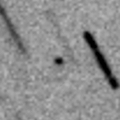
|
It will fade out rapidly after this. Now it is not observable. It will appear in September in the Northern Hemisphere. In the Southern Hemisphere, it will never be observable after this.
Date(TT) R.A. (2000) Decl. Delta r Elong. m1 Best Time(A, h)
Aug. 24 11 12.58 4 0.6 1.853 0.930 16 11.5 20:06 (102,-11)
Aug. 31 11 46.88 3 16.4 1.875 0.967 18 11.7 19:55 ( 99, -8)
|
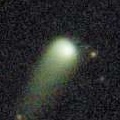
|
Now it is 12.5 mag (Aug. 7, Osamu Miyazaki). It stays 12 mag for a while. In the Northern Hemisphere, it stays observable in good condition. In the Southern Hemisphere, it is not observable now.
Date(TT) R.A. (2000) Decl. Delta r Elong. m1 Best Time(A, h)
Aug. 24 7 32.35 42 48.0 4.287 3.671 46 12.4 3:57 (236, 28)
Aug. 31 7 34.69 43 57.3 4.186 3.669 53 12.4 4:03 (237, 34)
|

|
Now it is 12.7 mag (Aug. 7, Thomas Lehmann). It stays 13 mag for a while. It stays extremely low in the Northern Hemisphere. But it will become high in spring. In the Southern Hemisphere, it will be getting lower gradually after this, and it will be unobservable in December.
Date(TT) R.A. (2000) Decl. Delta r Elong. m1 Best Time(A, h)
Aug. 24 16 19.08 -50 40.3 2.176 2.549 99 12.8 20:06 ( 18, 1)
Aug. 31 16 30.59 -48 8.3 2.220 2.521 95 12.7 19:55 ( 20, 3)
|

|
It brightened very rapidly up to 10.0 mag in June (June 11, Virgilio Gonano). Now it is 12.8 mag (Aug. 7, Hiroshi Abe). Fading rapidly. It will be fainter than 18 mag in November. It will be unobservable in October in the Southern Hemisphere, or in November in the Northern Hemisphere.
Date(TT) R.A. (2000) Decl. Delta r Elong. m1 Best Time(A, h)
Aug. 24 13 24.17 30 59.6 2.234 1.738 48 13.5 20:06 (108, 30)
Aug. 31 13 41.35 26 58.6 2.346 1.816 47 13.9 19:55 (104, 28)
|

|
Now it is 13.9 mag (Aug. 3, Ken-ichi Kadota). Fading gradually. In the Northern Hemisphere, it stays observable in good condition. It stays extremely low in the Southern Hemisphere.
Date(TT) R.A. (2000) Decl. Delta r Elong. m1 Best Time(A, h)
Aug. 24 6 58.07 36 42.7 2.207 1.747 50 13.8 3:57 (245, 32)
Aug. 31 7 18.37 36 30.8 2.199 1.783 52 14.3 4:03 (247, 35)
|
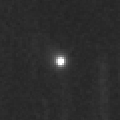
|
Now it is 15.1 mag (Aug. 17, ATLAS South Africa). Fading slowly. It stays extremely low in the Northern Hemisphere. In the Southern Hemisphere, it stays observable in good condition.
Date(TT) R.A. (2000) Decl. Delta r Elong. m1 Best Time(A, h)
Aug. 24 14 29.02 -22 33.8 1.710 1.686 71 14.0 20:06 ( 52, 11)
Aug. 31 14 46.97 -23 20.3 1.742 1.668 68 14.0 19:55 ( 51, 11)
|
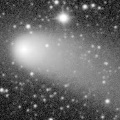
|
It brightened up to 9.6 mag from February to March (Feb. 25, Thomas Lehmann). Now it is 13.2 mag (Aug. 9, Osamu Miyazaki). Fading gradually. In the Northern Hemisphere, it stays observable in good condition. In the Southern Hemisphere, it will be unobservable in September.
Date(TT) R.A. (2000) Decl. Delta r Elong. m1 Best Time(A, h)
Aug. 24 19 20.31 56 26.9 2.495 2.905 103 14.1 21:07 (180, 69)
Aug. 31 19 19.95 54 39.8 2.562 2.979 104 14.3 20:39 (180, 70)
|

|
Now it is 14.5 mag (Aug. 16, ATLAS South Africa). It stays 14 mag for a while. In the Northern Hemisphere, it is not observable now, but it will appear in November. In the Southern Hemisphere, it will be unobservable in October. But it will be observable again in December.
Date(TT) R.A. (2000) Decl. Delta r Elong. m1 Best Time(A, h)
Aug. 24 12 51.90 -19 3.1 5.579 4.984 49 14.2 20:06 ( 70, -4)
Aug. 31 12 58.58 -18 56.0 5.654 4.983 44 14.2 19:55 ( 71, -6)
|
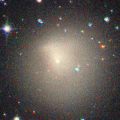
|
Now it is not observable. It will appear in September.
Date(TT) R.A. (2000) Decl. Delta r Elong. m1 Best Time(A, h)
Aug. 24 9 23.16 14 42.5 7.209 6.226 12 14.2 3:57 (247, -7)
Aug. 31 9 28.13 14 14.9 7.180 6.227 17 14.2 4:03 (252, -1)
|
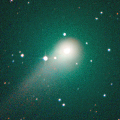
|
It was observed at 9-10 mag for a long time in 2023. Now it is 14.9 mag (Aug. 14, ATLAS Chile). Fading slowly. In the Northern Hemisphere, it will never be observable after this. In the Southern Hemisphere, it stays observable in good condition.
Date(TT) R.A. (2000) Decl. Delta r Elong. m1 Best Time(A, h)
Aug. 24 23 14.25 -69 30.9 4.753 5.342 120 14.7 1:06 ( 0,-14)
Aug. 31 22 54.41 -70 16.1 4.845 5.398 118 14.7 0:19 ( 0,-15)
|

|
It is expected to brighten up to 13 mag in 2025 autumn, and it will be observable in good condition. Now it is 14.7 mag (Aug. 4, W. Pei). It stays 15 mag for a while. It stays observable in good condition.
Date(TT) R.A. (2000) Decl. Delta r Elong. m1 Best Time(A, h)
Aug. 24 22 55.22 -4 11.2 3.837 4.828 167 14.8 0:46 ( 0, 51)
Aug. 31 22 52.39 -4 21.7 3.787 4.793 174 14.7 0:16 ( 0, 51)
|

|
Now it is 14.6 mag (July 31, Ken-ichi Kadota). It will fade out rapidly after this. It will be fainter than 18 mag in December. In the Northern Hemisphere, it stays observable in good condition.
Date(TT) R.A. (2000) Decl. Delta r Elong. m1 Best Time(A, h)
Aug. 24 4 45.64 9 5.0 1.208 1.436 80 14.9 3:57 (296, 45)
Aug. 31 5 1.51 11 21.0 1.181 1.450 82 15.1 4:03 (298, 50)
|
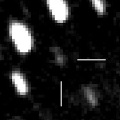
|
The condition is bad in this apparition. It must have brightened up to 10 mag in early summer, however, it is not observable at all. Fading rapidly. It will be fainter than 18 mag in October. It will never be observable after this.
Date(TT) R.A. (2000) Decl. Delta r Elong. m1 Best Time(A, h)
Aug. 24 10 46.38 15 29.7 2.605 1.616 9 15.0 20:06 (116, -9)
Aug. 31 11 4.76 13 48.7 2.668 1.676 8 15.4 19:55 (114,-10)
|

|
Now it is 14.7 mag (July 31, Ken-ichi Kadota). Fading gradually. It stays observable in good condition.
Date(TT) R.A. (2000) Decl. Delta r Elong. m1 Best Time(A, h)
Aug. 24 2 38.58 8 6.3 1.545 2.128 110 15.0 3:57 (343, 62)
Aug. 31 2 41.55 8 15.2 1.503 2.157 116 15.1 4:03 (359, 63)
|
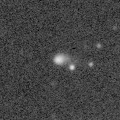
|
Now it is 15.6 mag (Aug. 18, ATLAS-HKO, Haleakala). It stays 15 mag for a while. In the Northern Hemisphere, it will be getting higher gradually. In the Southern Hemisphere, it stays observable in good condition.
Date(TT) R.A. (2000) Decl. Delta r Elong. m1 Best Time(A, h)
Aug. 24 6 22.93 3 25.8 6.635 6.147 57 15.2 3:57 (283, 23)
Aug. 31 6 27.09 3 23.9 6.526 6.125 62 15.1 4:03 (288, 29)
|
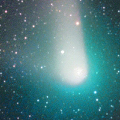
|
It brightened up to 8 mag from 2022 summer to 2023 spring. Now it is 14.9 mag (Aug. 10, Ken-ichi Kadota). It stays 16 mag for a while. In the Northern Hemisphere, it stays observable in good condition.
Date(TT) R.A. (2000) Decl. Delta r Elong. m1 Best Time(A, h)
Aug. 24 6 21.88 17 8.9 7.123 6.611 55 15.4 3:57 (270, 31)
Aug. 31 6 23.73 17 19.0 7.077 6.667 62 15.4 4:03 (275, 38)
|

|
Now it is 15.6 mag (July 24, Thomas Lehmann). It stays 16 mag for a while. In the Northern Hemisphere, it is not observable now, but it will appear in October. In the Southern Hemisphere, it will be getting higher gradually.
Date(TT) R.A. (2000) Decl. Delta r Elong. m1 Best Time(A, h)
Aug. 24 9 51.50 -24 20.8 3.949 3.185 35 15.5 3:57 (277,-35)
Aug. 31 9 52.89 -25 3.0 3.992 3.223 35 15.5 4:03 (282,-28)
|
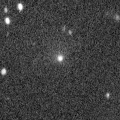
|
Very large comet. It is expected to brighten up to 13 mag in 2031. Now it is 15.9 mag (July 25, Hidetaka Sato). It stays 15 mag for a while. In the Northern Hemisphere, it is not observable now. In the Southern Hemisphere, it stays observable in good condition. In the Northern Hemisphere, it is not observable until 2030.
Date(TT) R.A. (2000) Decl. Delta r Elong. m1 Best Time(A, h)
Aug. 24 4 19.88 -65 56.2 15.835 16.030 99 15.5 3:57 (347,-14)
Aug. 31 4 21.12 -66 26.3 15.807 16.006 99 15.5 4:03 (350,-13)
|
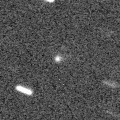
|
Now it is 16.5 mag (Apr. 3, Taras Prystavski). It stays 16 mag for a while. Now it is not observable. It will appear in September in the Northern Hemisphere, or in November in the Southern Hemisphere.
Date(TT) R.A. (2000) Decl. Delta r Elong. m1 Best Time(A, h)
Aug. 24 9 21.36 16 41.4 2.781 1.813 13 15.6 3:57 (246, -5)
Aug. 31 9 39.92 15 32.2 2.768 1.817 15 15.6 4:03 (249, -3)
|

|
It approached to Sun down to 0.12 a.u. on Aug. 4. Fading rapidly. It will be fainter than 18 mag in September. In the Northern Hemisphere, it will never be observable after this. In the Southern Hemisphere, it will be getting higher gradually.
Date(TT) R.A. (2000) Decl. Delta r Elong. m1 Best Time(A, h)
Aug. 24 9 0.18 -0 4.1 0.384 0.667 21 15.7 3:57 (262,-11)
Aug. 31 8 20.11 -17 34.7 0.274 0.830 42 15.9 4:03 (287, -6)
|
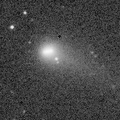
|
Now it is 14.7 mag (May 31, Hiroshi Abe). Fading slowly. Now it is not observable. It will appear in October in the Northern Hemisphere, or in November in the Southern Hemisphere.
Date(TT) R.A. (2000) Decl. Delta r Elong. m1 Best Time(A, h)
Aug. 24 10 41.55 15 31.8 3.302 2.307 8 15.7 20:06 (117,-10)
Aug. 31 10 55.45 14 5.3 3.334 2.336 6 15.8 19:55 (116,-11)
|

|
It approaches to Sun down to 0.09 a.u. on Jan. 13, 2025. According to the calculation, it will brighten up to -1 mag. But probably, it will be disintegrated. At the high light, it may be observable after the perihelion passage only in the Southern Hemisphere. Now it is 16.0 mag (Aug. 13, ATLAS Chile). It will brighten rapidly after this. In the Northern Hemisphere, it will never be observable after this. In the Southern Hemisphere, it will be getting lower gradually.
Date(TT) R.A. (2000) Decl. Delta r Elong. m1 Best Time(A, h)
Aug. 24 13 14.65 -55 9.8 2.975 2.910 76 16.0 20:06 ( 36,-21)
Aug. 31 13 22.14 -53 35.2 2.968 2.811 71 15.9 19:55 ( 38,-21)
|
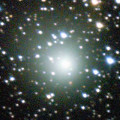
|
It brightened up to 8.3 mag in 2021-2022 winter (Jan. 6, 2022, Toshiyuki Takahashi). Now it is 16.3 mag (July 16, ATLAS Chile). It stays 16 mag for a while. In the Northern Hemisphere, it will never be observable after this. It locates somewhat low in the Southern Hemisphere. But it will become high in winter.
Date(TT) R.A. (2000) Decl. Delta r Elong. m1 Best Time(A, h)
Aug. 24 11 23.56 -46 27.8 9.011 8.547 59 15.9 20:06 ( 53,-33)
Aug. 31 11 28.59 -46 39.5 9.108 8.592 56 16.0 19:55 ( 54,-35)
|
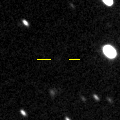
|
Now it is 16.5 mag (Aug. 7, D. Buczynski). Brightening slowly. In the Northern Hemisphere, it stays observable in good condition. In the Southern Hemisphere, it will be unobservable in September.
Date(TT) R.A. (2000) Decl. Delta r Elong. m1 Best Time(A, h)
Aug. 24 4 46.98 50 12.5 2.853 2.785 75 16.2 3:57 (230, 57)
Aug. 31 5 2.19 52 4.5 2.758 2.758 79 16.1 4:03 (225, 60)
|
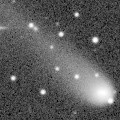
|
Now it is 14.9 mag (June 5, Thomas Lehmann). It stays 17 mag for a while. In the Northern Hemisphere, it is not observable now, but it will appear in September. In the Southern Hemisphere, it stays observable in good condition.
Date(TT) R.A. (2000) Decl. Delta r Elong. m1 Best Time(A, h)
Aug. 24 7 52.73 -35 39.9 6.198 5.714 57 16.1 3:57 (302,-17)
Aug. 31 7 54.23 -36 31.0 6.208 5.757 59 16.2 4:03 (306,-12)
|

|
It brightened very rapidly in outburst in late May. Now it is 16.3 mag (Aug. 15, ATLAS Chile). Fading slowly. It will be unobservable in November.
Date(TT) R.A. (2000) Decl. Delta r Elong. m1 Best Time(A, h)
Aug. 24 15 48.34 -22 37.2 3.068 3.211 88 16.1 20:06 ( 37, 22)
Aug. 31 15 55.01 -22 37.6 3.169 3.218 83 16.2 19:55 ( 39, 21)
|
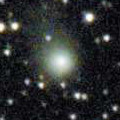
|
It brightened up to 12.1 mag in 2023 spring (May 20, 2023, Jose Guilherme de S. Aguiar). Now it is 16.3 mag (Aug. 2, ATLAS South Africa). It stays 17 mag for a while. In the Northern Hemisphere, it is not observable now, but it will appear in September. In the Southern Hemisphere, it stays observable in good condition.
Date(TT) R.A. (2000) Decl. Delta r Elong. m1 Best Time(A, h)
Aug. 24 6 52.12 -36 6.1 5.651 5.332 66 16.4 3:57 (309, -7)
Aug. 31 6 55.14 -36 26.7 5.660 5.381 68 16.4 4:03 (314, -3)
|
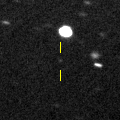
|
Now it is 16.4 mag (Aug. 18, ATLAS-HKO, Haleakala). It stays 16 mag for a while. In the Northern Hemisphere, it stays observable in good condition.
Date(TT) R.A. (2000) Decl. Delta r Elong. m1 Best Time(A, h)
Aug. 24 5 50.71 16 15.1 3.730 3.401 63 16.5 3:57 (276, 37)
Aug. 31 5 58.79 15 56.0 3.648 3.405 68 16.4 4:03 (280, 42)
|

|
Now it is 16.5 mag (Aug. 3, Ken-ichi Kadota). Fading gradually. It will be fainter than 18 mag in November. It stays observable in good condition.
Date(TT) R.A. (2000) Decl. Delta r Elong. m1 Best Time(A, h)
Aug. 24 23 48.16 -20 5.4 1.517 2.471 155 16.4 1:39 ( 0, 35)
Aug. 31 23 42.87 -20 24.0 1.519 2.493 160 16.5 1:07 ( 0, 35)
|

|
Now it is 16.0 mag (July 31, Ken-ichi Kadota). It will fade out rapidly after this. It will be fainter than 18 mag in October. In the Northern Hemisphere, it stays observable in good condition. It stays extremely low in the Southern Hemisphere.
Date(TT) R.A. (2000) Decl. Delta r Elong. m1 Best Time(A, h)
Aug. 24 6 1.12 27 21.2 2.106 1.838 60 16.4 3:57 (262, 40)
Aug. 31 6 15.41 28 37.6 2.089 1.888 64 16.6 4:03 (262, 44)
|
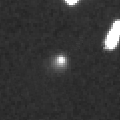
|
Now it is 16.6 mag (Aug. 2, ATLAS South Africa). It stays 16 mag for a while. It locates somewhat low in the Northern Hemisphere. In the Southern Hemisphere, it stays observable in good condition.
Date(TT) R.A. (2000) Decl. Delta r Elong. m1 Best Time(A, h)
Aug. 24 6 44.94 -24 54.5 7.428 7.011 62 16.5 3:57 (302, 1)
Aug. 31 6 49.21 -25 15.1 7.360 6.995 65 16.5 4:03 (307, 6)
|

|
Now it is 16.8 mag (Aug. 14, ATLAS Chile). It stays 17 mag for a while. In the Northern Hemisphere, it is not observable now, but it will appear in December. In the Southern Hemisphere, it will be getting lower gradually. But it will be getting higher again after October.
Date(TT) R.A. (2000) Decl. Delta r Elong. m1 Best Time(A, h)
Aug. 24 13 23.40 -40 24.0 5.632 5.334 67 16.5 20:06 ( 48,-11)
Aug. 31 13 23.60 -39 59.2 5.722 5.322 61 16.5 19:55 ( 50,-14)
|

|
It is expected to brighten up to 13.5 mag, and it will be observable in good condition in winter. Now it is 17.1 mag (Aug. 13, ATLAS South Africa). Brightening gradually. In the Northern Hemisphere, it will be getting higher gradually. In the Southern Hemisphere, it stays observable in good condition.
Date(TT) R.A. (2000) Decl. Delta r Elong. m1 Best Time(A, h)
Aug. 24 6 20.84 -29 59.9 2.159 2.032 69 16.8 3:57 (309, 2)
Aug. 31 6 28.85 -29 7.4 2.075 1.987 70 16.6 4:03 (313, 6)
|
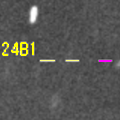
|
It stays 17 mag for a while. It locates somewhat low in the Northern Hemisphere. But it will become high in winter. In the Southern Hemisphere, it will never be observable after this.
Date(TT) R.A. (2000) Decl. Delta r Elong. m1 Best Time(A, h)
Aug. 24 8 22.20 45 17.4 2.364 1.740 41 16.8 3:57 (229, 22)
Aug. 31 8 52.28 46 59.1 2.279 1.710 44 16.6 4:03 (228, 23)
|

|
First return of a new periodic comet which brightened up to 16 mag in 2012. It is expected to brighten rapidly up to 14.5 mag in autumn. Now it is 18.5 mag (July 25, Hidetaka Sato). Brightening gradually. It stays observable in good condition.
Date(TT) R.A. (2000) Decl. Delta r Elong. m1 Best Time(A, h)
Aug. 24 4 10.56 0 3.2 1.612 1.908 90 17.0 3:57 (314, 45)
Aug. 31 4 19.21 1 57.1 1.522 1.888 94 16.6 4:03 (320, 50)
|
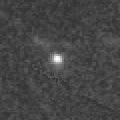
|
Now it is 17.5 mag (Mar. 9, Toshihiko Ikemura, Hirohisa Sato). Brightening slowly. In the Northern Hemisphere, it will be getting higher gradually. It stays extremely low in the Southern Hemisphere. But it will become high in winter.
Date(TT) R.A. (2000) Decl. Delta r Elong. m1 Best Time(A, h)
Aug. 24 7 12.60 27 50.9 3.454 2.834 45 16.7 3:57 (253, 26)
Aug. 31 7 24.57 27 26.4 3.373 2.819 49 16.6 4:03 (256, 30)
|

|
Now it is 16.5 mag (Aug. 15, Taras Prystavski). Fading gradually. It will be fainter than 18 mag in October. It stays observable in good condition.
Date(TT) R.A. (2000) Decl. Delta r Elong. m1 Best Time(A, h)
Aug. 24 23 14.00 2 5.6 1.396 2.371 159 16.7 1:07 ( 0, 57)
Aug. 31 22 38.27 -0 42.8 1.360 2.364 172 16.7 0:04 ( 0, 55)
|

|
Now it is 17.3 mag (May 6, ATLAS Chile). Brightening slowly. In the Northern Hemisphere, it is not observable now, but it will appear in September. In the Southern Hemisphere, it stays observable in good condition.
Date(TT) R.A. (2000) Decl. Delta r Elong. m1 Best Time(A, h)
Aug. 24 7 50.86 -26 2.4 5.202 4.627 50 16.7 3:57 (294,-12)
Aug. 31 7 55.59 -25 56.2 5.140 4.595 52 16.7 4:03 (298, -6)
|
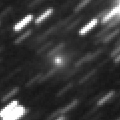
|
Very far object. Now it is 17.1 mag (Aug. 10, ATLAS Chile). It stays 17 mag for a while. In the Northern Hemisphere, it is not observable now. In the Southern Hemisphere, it stays observable in good condition.
Date(TT) R.A. (2000) Decl. Delta r Elong. m1 Best Time(A, h)
Aug. 24 2 51.52 -67 44.0 10.069 10.423 107 16.7 3:57 (356,-13)
Aug. 31 2 46.42 -68 12.6 10.070 10.429 108 16.7 4:03 ( 0,-13)
|
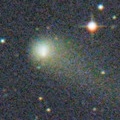
|
It brightened up to 11.1 mag in early 2022 (Mar. 31, 2022, F. Kugel, J.-G. Bosch, J. Nicolas). Now it is 16.1 mag (Aug. 1, ATLAS-MLO, Mauna Loa). It stays 17 mag for a while. In the Northern Hemisphere, it stays observable in good condition. In the Southern Hemisphere, it will be unobservable in October.
Date(TT) R.A. (2000) Decl. Delta r Elong. m1 Best Time(A, h)
Aug. 24 17 12.61 30 1.3 7.390 7.583 97 16.7 20:06 ( 75, 75)
Aug. 31 17 13.28 29 26.7 7.498 7.624 93 16.8 19:55 ( 78, 72)
|
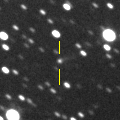
|
It stays 17 mag for a while. It will be getting higher gradually.
Date(TT) R.A. (2000) Decl. Delta r Elong. m1 Best Time(A, h)
Aug. 24 7 27.32 15 49.9 5.558 4.831 40 17.0 3:57 (262, 17)
Aug. 31 7 33.44 15 4.6 5.488 4.834 45 17.0 4:03 (267, 22)
|

|
Now it is 16.8 mag (Aug. 3, Ken-ichi Kadota). It will fade out rapidly after this. It will be fainter than 18 mag in October. In the Northern Hemisphere, it stays observable in good condition. It stays extremely low in the Southern Hemisphere.
Date(TT) R.A. (2000) Decl. Delta r Elong. m1 Best Time(A, h)
Aug. 24 3 21.48 33 58.5 1.528 1.890 94 17.0 3:57 (268, 74)
Aug. 31 3 32.58 36 9.0 1.479 1.900 97 17.0 4:03 (260, 79)
|
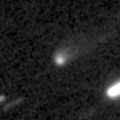
|
Now it is 16.6 mag (Aug. 12, ATLAS Chile). It stays 17 mag for a while. It will be unobservable in September in the Northern Hemisphere, or in October in the Southern Hemisphere. But it will be observable again in December in the Northern Hemisphere.
Date(TT) R.A. (2000) Decl. Delta r Elong. m1 Best Time(A, h)
Aug. 24 13 24.78 -5 5.9 3.802 3.255 50 17.0 20:06 ( 76, 10)
Aug. 31 13 32.59 -6 6.3 3.860 3.242 46 17.0 19:55 ( 76, 8)
|
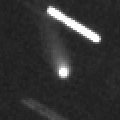
|
It has started fading before the perihelion passage. Now it is 17.0 mag (Aug. 11, Thomas Lehmann). Fading slowly. It will be fainter than 18 mag in November. In the Northern Hemisphere, it will never be observable after this. It locates somewhat low in the Southern Hemisphere.
Date(TT) R.A. (2000) Decl. Delta r Elong. m1 Best Time(A, h)
Aug. 24 9 1.87 -63 59.7 2.848 2.787 76 17.0 3:57 (328,-37)
Aug. 31 9 39.85 -64 36.2 2.901 2.798 74 17.1 4:03 (329,-37)
|

|
Now it is 17.8 mag (Aug. 16, ATLAS-MLO, Mauna Loa). It stays 17 mag for a while. It stays observable in good condition.
Date(TT) R.A. (2000) Decl. Delta r Elong. m1 Best Time(A, h)
Aug. 24 0 56.60 1 48.8 1.218 2.076 137 17.2 2:47 ( 0, 57)
Aug. 31 0 58.11 1 24.1 1.164 2.065 143 17.1 2:21 ( 0, 57)
|

|
Now it is 17.0 mag (Aug. 18, ATLAS-MLO, Mauna Loa). It stays 17 mag for a while. In the Northern Hemisphere, it stays observable in good condition. It locates somewhat low in the Southern Hemisphere.
Date(TT) R.A. (2000) Decl. Delta r Elong. m1 Best Time(A, h)
Aug. 24 23 42.43 32 1.8 5.516 6.235 131 17.2 1:34 ( 0, 87)
Aug. 31 23 34.91 31 50.1 5.411 6.190 137 17.1 0:59 ( 0, 87)
|
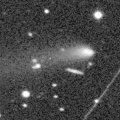
|
It brightened up to 14 mag in early 2023 and 2023 autumn. Now it is 17.1 mag (Aug. 14, A. Diepvens). Fading slowly. It will be fainter than 18 mag in October. It stays observable in good condition.
Date(TT) R.A. (2000) Decl. Delta r Elong. m1 Best Time(A, h)
Aug. 24 21 2.92 21 30.7 4.398 5.243 143 17.2 22:49 ( 0, 77)
Aug. 31 20 54.06 20 50.9 4.466 5.289 141 17.2 22:13 ( 0, 76)
|

|
Now it is 16.4 mag (May 4, Toshiyuki Takahashi). It stays 17 mag for a while. It will be getting lower gradually after this, and it will be unobservable in November in the Southern Hemisphere, or in December in the Northern Hemisphere.
Date(TT) R.A. (2000) Decl. Delta r Elong. m1 Best Time(A, h)
Aug. 24 15 32.99 -4 58.4 2.844 2.872 81 17.3 20:06 ( 53, 34)
Aug. 31 15 40.46 -5 38.9 2.932 2.875 76 17.3 19:55 ( 54, 32)
|
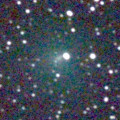
|
First return of a new periodic comet which was discovered in 2011, half a year after the perihelion passage. It brightened very rapidly up to 10.7 mag in spring (Apr. 28, Marco Goiato). Now it is 17.8 mag (July 26, ATLAS Chile). Fading rapidly. It will be fainter than 18 mag in September. It locates somewhat low in the Northern Hemisphere. In the Southern Hemisphere, it stays observable in good condition.
Date(TT) R.A. (2000) Decl. Delta r Elong. m1 Best Time(A, h)
Aug. 24 16 6.82 -27 11.5 1.529 1.889 93 17.3 20:06 ( 31, 21)
Aug. 31 16 24.67 -26 46.4 1.652 1.951 91 17.8 19:55 ( 31, 21)
|
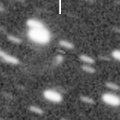
|
Now it is 17.2 mag (July 21, Ken-ichi Kadota). It stays 18 mag for a while. In the Northern Hemisphere, it stays observable in good condition. It locates somewhat low in the Southern Hemisphere.
Date(TT) R.A. (2000) Decl. Delta r Elong. m1 Best Time(A, h)
Aug. 24 19 56.53 43 6.9 3.828 4.388 117 17.3 21:43 (180, 82)
Aug. 31 19 44.85 41 8.4 3.863 4.405 116 17.4 21:04 (180, 84)
|

|
Now it is 17.0 mag (Aug. 15, ATLAS Chile). It stays 17 mag for a while. It will be unobservable in September in the Northern Hemisphere, or in October in the Southern Hemisphere. But it will be observable again in December.
Date(TT) R.A. (2000) Decl. Delta r Elong. m1 Best Time(A, h)
Aug. 24 15 12.43 -31 2.3 3.889 3.902 83 17.4 20:06 ( 39, 11)
Aug. 31 15 8.77 -30 27.2 3.995 3.872 75 17.4 19:55 ( 43, 8)
|

|
It will brighten up to 14 mag in 2025 spring. Now it is 17.9 mag (Aug. 13, ATLAS South Africa). It stays 17 mag for a while. It locates somewhat low in the Northern Hemisphere. In the Southern Hemisphere, it stays observable in good condition.
Date(TT) R.A. (2000) Decl. Delta r Elong. m1 Best Time(A, h)
Aug. 24 0 25.55 -21 31.6 1.749 2.651 146 17.6 2:16 ( 0, 34)
Aug. 31 0 22.82 -23 4.8 1.675 2.604 150 17.4 1:46 ( 0, 32)
|

|
It stays 18 mag for a while. In the Northern Hemisphere, it will be getting higher gradually. In the Southern Hemisphere, it is not observable now, but it will appear in October.
Date(TT) R.A. (2000) Decl. Delta r Elong. m1 Best Time(A, h)
Aug. 24 7 30.27 36 45.7 2.729 2.129 44 17.5 3:57 (242, 26)
Aug. 31 7 47.68 36 25.3 2.705 2.156 47 17.5 4:03 (244, 29)
|

|
Now it is 18.0 mag (Aug. 16, ATLAS-MLO, Mauna Loa). It will fade out rapidly after this. It will be fainter than 18 mag in September. It stays observable in good condition.
Date(TT) R.A. (2000) Decl. Delta r Elong. m1 Best Time(A, h)
Aug. 24 21 19.26 -12 34.7 1.189 2.186 166 17.5 23:06 ( 0, 42)
Aug. 31 21 15.18 -13 41.1 1.254 2.226 159 17.7 22:35 ( 0, 41)
|

|
Now it is 18.3 mag (Aug. 15, ATLAS South Africa). It stays 17 mag for a while. It stays observable in good condition.
Date(TT) R.A. (2000) Decl. Delta r Elong. m1 Best Time(A, h)
Aug. 24 23 1.28 -6 3.9 1.278 2.275 166 17.7 0:53 ( 0, 49)
Aug. 31 22 57.15 -6 18.7 1.242 2.249 174 17.5 0:21 ( 0, 49)
|

|
Now it is 17.9 mag (Aug. 7, ATLAS-HKO, Haleakala). Fading slowly. It will be fainter than 18 mag in November. In the Northern Hemisphere, it stays observable in good condition. It locates somewhat low in the Southern Hemisphere.
Date(TT) R.A. (2000) Decl. Delta r Elong. m1 Best Time(A, h)
Aug. 24 2 44.76 22 33.2 1.809 2.293 105 17.6 3:57 (323, 75)
Aug. 31 2 47.95 24 26.5 1.738 2.297 110 17.5 4:03 (351, 79)
|
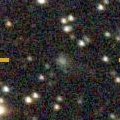
|
Now it is 17.6 mag (Apr. 11, Mt. Lemmon Survey). It stays 18 mag for a while. In the Northern Hemisphere, it stays observable in good condition. In the Southern Hemisphere, it will be unobservable in September.
Date(TT) R.A. (2000) Decl. Delta r Elong. m1 Best Time(A, h)
Aug. 24 7 6.17 38 40.7 7.472 6.860 49 17.6 3:57 (242, 32)
Aug. 31 7 11.63 38 43.6 7.400 6.870 54 17.6 4:03 (245, 37)
|

|
Now it is 17.4 mag (Aug. 12, ATLAS South Africa). It stays 18 mag for a while. It will be unobservable in December. It is expected to brighten up to 13 mag in 2026, and it will be observable in excellent condition in the Northern Hemisphere. In the Southern Hemisphere, it locates very low at the high light.
Date(TT) R.A. (2000) Decl. Delta r Elong. m1 Best Time(A, h)
Aug. 24 18 27.89 -39 34.3 7.075 7.673 123 17.6 20:16 ( 0, 15)
Aug. 31 18 25.56 -39 2.0 7.129 7.630 116 17.6 19:55 ( 2, 16)
|

|
Now it is 19.0 mag (Aug. 6, W. Hasubick). Fading slowly. It will be fainter than 18 mag in October. It stays observable in good condition.
Date(TT) R.A. (2000) Decl. Delta r Elong. m1 Best Time(A, h)
Aug. 24 23 58.88 -5 56.6 1.585 2.529 153 17.7 1:50 ( 0, 49)
Aug. 31 23 55.67 -6 13.3 1.555 2.529 160 17.7 1:19 ( 0, 49)
|
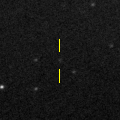
|
Now it is 19.0 mag (Aug. 11, W. Hasubick). It stays 17 mag for a while. It stays observable in good condition.
Date(TT) R.A. (2000) Decl. Delta r Elong. m1 Best Time(A, h)
Aug. 24 4 9.01 -3 56.2 3.854 4.010 91 17.8 3:57 (317, 42)
Aug. 31 4 12.98 -4 47.8 3.759 4.006 96 17.7 4:03 (327, 45)
|
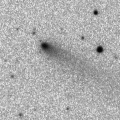
|
Now it is 18.5 mag (Aug. 11, W. Hasubick). It stays 18 mag for a while. It stays observable in good condition.
Date(TT) R.A. (2000) Decl. Delta r Elong. m1 Best Time(A, h)
Aug. 24 3 36.73 16 43.3 4.180 4.387 95 17.8 3:57 (306, 63)
Aug. 31 3 38.36 16 51.6 4.088 4.401 101 17.8 4:03 (321, 68)
|

|
First return of a new periodic comet which brightened up to 15 mag in 2010. Now it is 19.1 mag (Aug. 13, John Maikner). It stays 18 mag for a while. In the Northern Hemisphere, it stays observable in good condition. It stays extremely low in the Southern Hemisphere.
Date(TT) R.A. (2000) Decl. Delta r Elong. m1 Best Time(A, h)
Aug. 24 6 32.08 31 15.4 2.209 1.818 54 18.1 3:57 (254, 35)
Aug. 31 6 51.91 31 25.9 2.177 1.834 56 18.0 4:03 (255, 38)
|
|
![]()
 32P/Comas Sola
32P/Comas Sola C/2024 G3 ( ATLAS )
C/2024 G3 ( ATLAS ) C/2019 L3 ( ATLAS )
C/2019 L3 ( ATLAS ) C/2023 Q1 ( PanSTARRS )
C/2023 Q1 ( PanSTARRS ) C/2019 U5 ( PanSTARRS )
C/2019 U5 ( PanSTARRS ) 299P/Catalina-PanSTARRS
299P/Catalina-PanSTARRS C/2020 K1 ( PanSTARRS )
C/2020 K1 ( PanSTARRS ) 472P/2023 RL75 ( NEAT-LINEAR )
472P/2023 RL75 ( NEAT-LINEAR ) 89P/Russell 2
89P/Russell 2 192P/Shoemaker-Levy 1
192P/Shoemaker-Levy 1 C/2022 R6 ( PanSTARRS )
C/2022 R6 ( PanSTARRS ) C/2023 F3 ( ATLAS )
C/2023 F3 ( ATLAS ) C/2024 M1 ( ATLAS )
C/2024 M1 ( ATLAS ) C/2024 B1 ( Lemmon )
C/2024 B1 ( Lemmon ) P/2024 N5 ( Siding Spring )
P/2024 N5 ( Siding Spring ) P/2023 S1
P/2023 S1 C/2023 TD22 ( Lemmon )
C/2023 TD22 ( Lemmon ) C/2024 A1 ( ATLAS )
C/2024 A1 ( ATLAS ) C/2019 E3 ( ATLAS )
C/2019 E3 ( ATLAS ) C/2019 T4 ( ATLAS )
C/2019 T4 ( ATLAS ) C/2022 U3 ( Bok )
C/2022 U3 ( Bok ) 328P/LONEOS-Tucker
328P/LONEOS-Tucker 65P/Gunn
65P/Gunn C/2022 S4 ( Lemmon )
C/2022 S4 ( Lemmon ) 253P/PanSTARRS
253P/PanSTARRS C/2023 R1 ( PanSTARRS )
C/2023 R1 ( PanSTARRS ) C/2021 X1 ( Maury-Attard )
C/2021 X1 ( Maury-Attard ) 362P/(457175) 2008 GO98
362P/(457175) 2008 GO98 479P/2023 WM26 ( Elenin )
479P/2023 WM26 ( Elenin ) C/2022 U1 ( Leonard )
C/2022 U1 ( Leonard ) C/2024 L5 ( ATLAS )
C/2024 L5 ( ATLAS ) 49P/Arend-Rigaux
49P/Arend-Rigaux 50P/Arend
50P/Arend 125P/Spacewatch
125P/Spacewatch 190P/Mueller
190P/Mueller 338P/McNaught
338P/McNaught C/2021 S4 ( Tsuchinshan )
C/2021 S4 ( Tsuchinshan ) C/2024 J3 ( ATLAS )
C/2024 J3 ( ATLAS ) 208P/McMillan
208P/McMillan 242P/Spahr
242P/Spahr 117P/Helin-Roman-Alu 1
117P/Helin-Roman-Alu 1 P/2010 WK ( LINEAR )
P/2010 WK ( LINEAR )![]()



























































